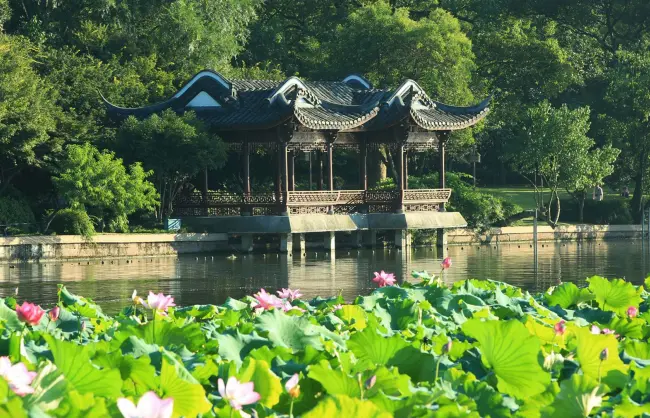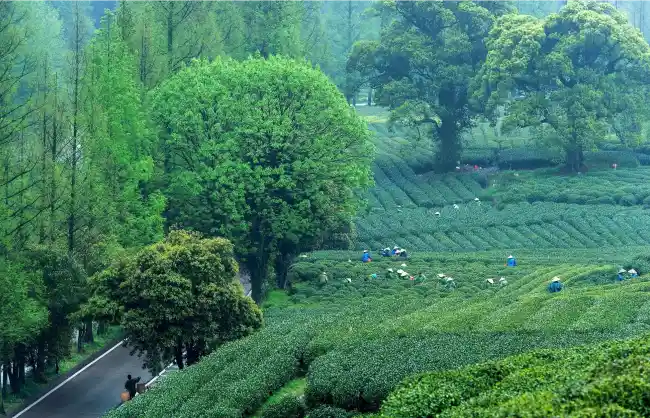Written by Natalia |
When it comes to the most beautiful cities in China, Hangzhou must have its place among the tops. This next megacity is one of China’s six ancient capitals, and just an hour away from Shanghai. She holds countless surprises beyond its famous West Lake. If you’re planning a Hangzhou tour or simply curious to find out more interesting facts about this charming city, you’ve come to the right place. We have listed these 12 fascinating facts about Hangzhou that might surprise you.

Hangzhou Is One of China’s Six Ancient Capitals
Among the many facts about Hangzhou, its status as one of China’s six ancient capitals stands out. You must have heard the historical significance of Beijing and Xi’an, but Hangzhou, despite how modern it is nowadays, used to be as prominent as the other two. It served as the capital of the Wuyue Kingdom during the Five Dynasties period and the Southern Song Dynasty (1127–1279). The latter one is the most economically and commercially exuberant dynasty in Chinese history. The city’s rich heritage is evident scattered across the city center. If you are a history buff planning an in-depth Hangzhou travel, you should definitely add sites like the Lingyin Temple and Leifeng Pagoda to your list!
Water Buses Show You the Real Hangzhou for Just 3 RMB
One of the best things to feel close to Hangzhou’s soul is its affordable water bus system. For just three yuan, you can hop on a water bus along the grand canal, cruising along the river and getting an authentic glimpse of local life away from tourist crowds. It is like drifting through centuries of history. Green trees lean over the water’s edge. Their leaves brush the surface softly.
There are 4 lines for you to choose from. We recommend Route Line 1- the most classic route. This route takes you past cultural and artistic landmarks like Gongchen Bridge and Xiaohe Park, as well as Hangzhou icons such as Wulin Square and West Lake Cultural Square. The whole journey takes approximately 40 minutes.
Hangzhou Is the Tea Capital of China
No facts about Hangzhou would be complete without mentioning tea. As the birthplace of Longjing (Dragon’s Well) tea, one of China’s most famous green teas, Hangzhou’s tea culture runs deep. Real Loongjing tea comes only from West Lake’s hills. The government are protecting this tea. A Hangzhou trip isn’t complete without visiting a tea plantation and learning the proper way to brew this delicate beverage.
Just an Hour by Train From Shanghai
Thanks to China’s high-speed rail network, the high-speed train connects these two megacities in just 45-60 minutes, making it convenient for business errands or cozy day trips. Many visitors combine Shanghai, Jiaxing (an ancient water town in between) and Hangzhou tours altogether to explore both modern and classical sides of China.
Marco Polo Called Hangzhou “The Finest and Most Splendid City in the World”
In the 13th century, the legendary Italian explorer Marco Polo journeyed to China during the Yuan Dynasty. Of all the cities he visited, none captured his heart quite like Hangzhou. The city’s canals and waterways may have reminded him of his hometown, Venice. This connection might explain why he loved it so much. In his book, The Travels of Marco Polo, he gave Hangzhou the highest praise, calling it “the finest and most splendid city in the world” and remarking that “a man could believe himself in paradise” when dwelling within it.
At that time, Hangzhou is called “Quinsay 行在” (also spelled Quinsai). Marco portrayed this city in extensive details as if he was painting it through words. He depictied its urban landscape, bustling markets, skilled craftsmanship, social dynamics, and vibrant cultural life, which all he found utterly enchanting and to keep in his memory forever.
The travelogue broadly recounts his journey through the East, with China as the central focus. Among Chinese cities, he gave detailed descriptions of Beijing and Hangzhou. Remarkably, the sections on Hangzhou occupy about one-fifteenth of the entire book — not only rich in content but also considered “the most brilliant and important chapters” of the work.

Hangzhou Boasts Three UNESCO World Heritage Sites
Adding to the impressive facts about Hangzhou, the city claims three UNESCO listings. Hangzhou protects these places carefully. The city keeps their history alive. Tourists can walk the same paths as ancient traders. They can see landscapes that inspired famous paintings. Every visit tells you something special about China’s culture, as you become part of its life.
- West Lake Cultural Landscape: It mixes nature and human design perfectly. The lake has inspired poets and artists for centuries. Willow trees frame its shores. Ancient pagodas dot the landscape.
- The Grand Canal: It’s the world’s longest man-made waterway. Builders made it over 2,500 years ago. The canal connected north and south China. It helped trade and travel for generations.
- Liangzhu Archaeological Site: Evidence of a 5,000-year-old civilization, offering insights into early urban development. It is 40 minutes from downtown, and nowadays it becomes a neighborhood for independent artists to run their studios and collaborate with each other.
Hangzhou’s Museums Showcase Unique Collections
It’s like a treasure trove to visit museums in Hangzhou. Many of them have prepared cultural derivatives designed by domestic and world-famous artists, which make those cute little products ideal as souvenirs or a personal collection to remember the trip.
- Zhejiang Provincial Museum:It holds treasures from China’s past. Its collection includes more than 100,000 artifacts. Visitors see delicate jade carvings from ancient times. Colorful ceramics show centuries of craftsmanship. Some pieces date back 5,000 years.
- China National Silk Museum: The world’s largest silk museum, detailing the history and craftsmanship of silk production. You’ll see royal robes worn by emperors. Workers demonstrate traditional weaving techniques.
- China Jiangnan Water Town Culture Museum: It recreates old canal houses and stone bridges. Sound effects play gentle lapping waves. The museum feels like stepping into a watercolor painting.
Hangzhou Silk Is World-Renowned
For over 2,000 years, Hangzhou has produced some of China’s finest silk. The China Silk Museum (the nation’s largest) showcases this luxurious heritage. Visitors on Hangzhou travel often purchase silk products as premium souvenirs.
West Lake’s Nighttime Magic
Wulin Square Music Fountain & 3D Light Show
Modern skyscrapers frame Wulin Square’s fountain. The Theater of Hangzhou stands nearby. Zhejiang Exhibition Hall watches quietly from the side. Eight fairy statues bring magic to the scene. Three fairies float mid-air, dancing on water mist. Five others sit on stone petals, playing ancient instruments.
- Ticket: free
- Location: Yan’an Road, Wulin Square; northeast side of West Lake and about 2.4 kilometers from Broken Bridge.
West Lake Light & Music Show
This is the signature of Hangzhou night scenes. It stretches longer than a football field – 126 meters of dancing water. The arc sprays reach 2 meters wide, like liquid rainbows. Special nozzles spin full circles. They create shapes in mid-air. Water columns shoot sky-high. Mist floats like morning fog. Some bursts form perfect spheres that hover before falling. Underwater LED lights are capable of changing colors. Drones sometimes join the show. They form glowing pictures above the water. Stars, dragons, and lotus flowers appear in the night sky. The music mixes old and new. Traditional West Lake melodies play first. “Once Every a Thousand Years” brings classic charm. “Tea Picking Dance” honors local culture. Modern pop songs get people cheering.
- Ticket: free
- Location: at the lakeside near Third Park of West Lake.

Charming Ancient Water Towns Surround Hangzhou
Within easy reach for Hangzhou tours, there are picturesque water towns like:
- Wuzhen: Stone bridges arch over quiet canals. Wooden boats glide past Ming Dynasty houses. At night, red lanterns glow bove the water.
- Jiaxing/Xitang: This town inspired scenes in “Mission Impossible 3.” Narrow lanes run beside the canals. Wisteria vines climb old teahouses.
- Nanxun:It mixes Chinese and Western architecture. Grand mansions stand beside traditional gardens. Fewer tourists come here than to Suzhou.
54 Nationalities Enjoy 240-Hour Visa-Free Transit
Great news for international travelers! China just made visiting Hangzhou simpler. On December 17, 2025, new rules took effect.
China has extended the previous 72 and 144-hour visa-free transit policy to 240 hours. Citizens from fifty-four countries, including Russia, Brazil, the United Kingdom, the United States of America, and Canada, can enter China visa-free through any of the 60 open ports in 24 provinces (including Hangzhou) as long as they meet certain requirements.
Hangzhou Scenes Appear on Chinese Currency and Passports
Hangzhou’s West Lake appears where you least expect it! The “Three Pools Mirroring the Moon,” one of West Lake’s ten scenic spots, is featured on the back of China’s one-yuan banknote. The same image appears in Chinese passports too. You’ll find it on page 20. The government chose this scene carefully, as if it is a signature of China’s natural beauty. This official recognition underscores Hangzhou’s status as a national treasure.







